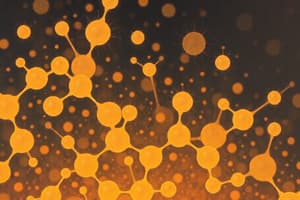Podcast
Questions and Answers
Which of the following are classes of biomolecules?
Which of the following are classes of biomolecules?
- Carbohydrates
- Proteins
- Lipids
- All of the above (correct)
What is the process of building organic molecules by living organisms called?
What is the process of building organic molecules by living organisms called?
Biosynthesis
Lipids are soluble in water.
Lipids are soluble in water.
False (B)
Carbohydrates are made of C, H, and ___
Carbohydrates are made of C, H, and ___
What are the building blocks of proteins?
What are the building blocks of proteins?
Which of the following is NOT a function of lipids?
Which of the following is NOT a function of lipids?
Saturated fats have at least one double bond in their fatty acid chain.
Saturated fats have at least one double bond in their fatty acid chain.
What type of nucleic acid carries genetic material?
What type of nucleic acid carries genetic material?
Match the following functions with the biomolecules:
Match the following functions with the biomolecules:
Study Notes
Biomolecules - Structure and Function
- Biomolecules, also known as macromolecules, are organic compounds essential for life.
- Monomers are the basic building blocks of polymers, which are larger molecules formed by linking monomers together.
- The four main classes of biomolecules are carbohydrates, lipids, proteins, and nucleic acids.
Carbohydrates
- Carbohydrates are composed of carbon, hydrogen, and oxygen.
- They are classified as simple sugars (monosaccharides and disaccharides) or complex sugars (polysaccharides).
- Carbohydrates serve as:
- Primary energy source for humans.
- Energy storage (glycogen).
- Structural support for cells (cellulose and chitin).
- Food (starch).
Lipids
- Lipids are a diverse group of substances insoluble in water but soluble in nonpolar solvents.
- They have three main functions:
- Energy storage (triglycerides or fats).
- Structural component of cell membranes (phospholipids).
- Chemical messengers (steroids).
- Fats are triglycerides made up of saturated or unsaturated fatty acids.
- Saturated fats have no double bonds, are solid at room temperature, and commonly found in animal fats.
- Unsaturated fats have at least one double bond, are liquid at room temperature, and commonly found in plants.
Proteins
- Proteins are complex macromolecules with diverse structures and functions.
- They are polymers of amino acids, with 20 different amino acids commonly found in proteins.
- Amino acids consist of an amino group, a carboxyl group, a central carbon atom, and a variable side chain.
- Proteins are classified based on function, including:
- Structural proteins: Keratin in hair.
- Regulatory proteins: Hormones like insulin.
- Contractile proteins: Actin and myosin.
- Protective proteins: Antibodies produced by white blood cells.
- Transport proteins: Hemoglobin that carries oxygen.
- Storage proteins: Egg albumin that nourishes developing embryos.
Nucleic Acids
- Nucleic acids are the most important biomolecules for the continuity of life.
- They are polymers of nucleotides, composed of a pentose sugar, a phosphate group, and a nitrogenous base.
- There are two main types of nucleic acids:
- Deoxyribonucleic acid (DNA): Carries genetic information.
- Ribonucleic acid (RNA): Involved in protein synthesis.
Studying That Suits You
Use AI to generate personalized quizzes and flashcards to suit your learning preferences.
Related Documents
Description
This quiz explores the structure and function of biomolecules, including carbohydrates, lipids, proteins, and nucleic acids. Learn how these macromolecules serve essential roles in biological systems, from energy storage to cellular structure. Test your understanding of their classifications and functions in living organisms.




